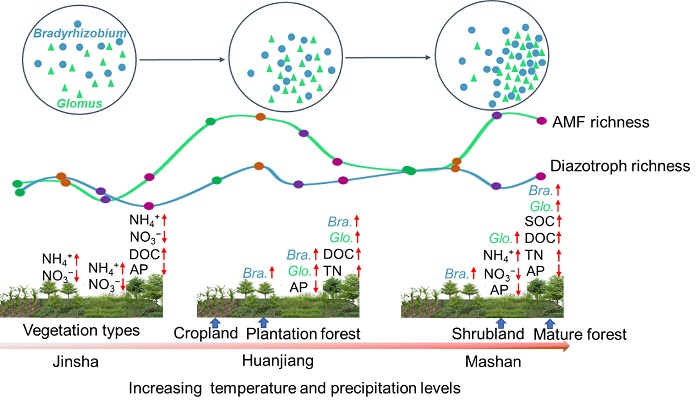New Scientific Soil Nutrient Recovery Strategies Helps Vegetation Restoration
The karst ecosystem is particularly fragile as its unique geological background and high calcium and pH soil conditions determining a distinct nutrient turnover mechanism driven by diazotrophs and arbuscular mycorrhizal fungi (AMF). The researcher group of Prof. Wang Kelin from the Institute of Subtropical Agriculture (ISA) of the Chinese Academy of Sciences (CAS) conducted an serial investigation to assess the abundance, diversity, and community composition of diazotrophs and AMF in karst moutainous regions of Southwest China, and explored the cooperation among different taxa of diazotrophs and AMF under various vegetation restoration strategies.
According to their recent research results, the distribution of diazotrophs and AMF in karst areas is influenced by various factors, including plant diversity, climate conditions, habitat heterogeneity, slope position, and soil depth. Generally, soil environments with high availability of nutrients, such as carbon sources, contribute to increased abundance of diazotrophs and AMF. For instance, areas located downhill and topsoil with rich nutrients, resulting from higher plant diversity and root biomass, exhibit higher abundance of diazotrophs and AMF compared to those on upper slopes and in deeper soil layers (Fig. 1). Additionally, plant diversity plays a crucial role in determining AMF abundance and diversity. High habitat heterogeneity, coupled with abundant shrub diversity on the rocky soil surface, enhances AMF abundance and diversity compared to soil surfaces and rocky gullies, despite the lower soil nutrient levels observed in the rocky soil surface habitat (Fig. 2). These findings further underscore the mutually beneficial relationship between plants and mycorrhiza in karst ecosystems.
Additionally, the cooperative relationship between diazotrophs and AMF offers mutual benefits to their host plants and enhances free-living N fixation. Karst forests exhibit stronger interactions among diazotrophs and AMF taxa compared to non-karst forests, which is primarily due to the increased nitrogen-fixing activity and diversity of diazotrophs in karst forests. However, the advancement of this phenomenon is strongly influenced by climate conditions, with rising temperatures and precipitation levels contributing to heightened network complexity between diazotroph and AMF taxa (Fig. 3). Furthermore, the interactions between diazotrophs and AMF species, rather than their individual abundance and diversity, have been identified as the primary driving factors in augmenting free-living N fixation activity at the soil-rock mixing layer as opposed to the topsoil (Fig. 4). Among these cooperating taxa, diazotrophs belonging to Bradyrhizobium and AMF belonging to Glomus emerge as keystone taxa, indicating their potential as key factors for karst vegetation restoration (Fig. 3).
Collectively, these studies emphasize the potential of vegetation restoration in calcareous soils to enhance nutrient transfer and absorption, enabling plants to adapt to environments with limited soil nutrients. This enhancement is achieved by fostering closer cooperation among the keystone taxa of diazotrophs and AMF. Consequently, the mutualistic roles of these microbial taxa should be considered during vegetation restoration efforts in karst regions.
“Our research on the diazotroph and AMF communities in karst vegetation restoration will help elucidate the microbial mechanisms driving soil nutrient accumulation, especially nitrogen (N), which is crucial for combating rocky desertification in degraded ecosystems.” said Prof. Xiao Dan, the first author, “It will scientificly develop new soil nutrient recovery strategies tailored to different soil systems, ultimately promoting vegetation restoration.”
The study was supported by the National Key Research and Development Program, the State Key Program of National Natural Science Foundation of China, the National Natural Science Foundation of China, Guangxi Natural Science Foundation Program, and the Youth Innovation Promotion Association of the Chinese Academy of Sciences Program.
All those studies were published in Geoderma, Catena, Plant and Soil, Forest Ecology and Management, and Applied Soil Ecology. More details can be found at
(1)https://www.sciencedirect.com/science/article/pii/S001670612300277X
(2)https://www.sciencedirect.com/science/article/pii/S0341816223006045
(3)https://link.springer.com/article/10.1007/s11104-023-06004-8
(4)https://www.sciencedirect.com/science/article/pii/S0378112721005533
(5)https://www.sciencedirect.com/science/article/pii/S0929139321003504
Contact: Kelin Wang
E-mail: kelin@isa.ac.cn
Institute of Subtropical Agriculture, Chinese Academy of Sciences

Fig.1 Conceptual model revealing characteristics of AMF at different slope positions.(Image by Xiao Dan)

Fig.2 Habitat heterogeneity drives AMF and shrub communities.(Image by Xiao Dan)

Fig.3 Relationships between climate factors, soil properties, and AMF and diazotroph indices.(Image by Xiao Dan)

Fig.4 Diazotroph and AMF driving free-living N fixation activity at different soil depths.(Image by Xiao Dan)
Download attachments: